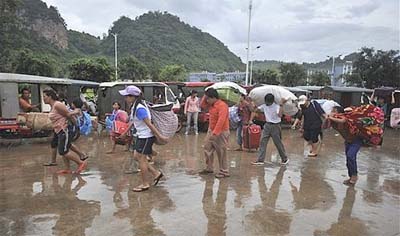The groups that agreed to stop their armed resistance to Burmese military rule draw their strength—numerical and ideological—from the country’s major non-Burman populations. Along the haphazardly-guarded frontier between China and Burma these ethnic political-military organisations have built semi-autonomous economies on gambling, gems, timber and drugs. It is the drugs, both heroin and amphetamines, that have made some of the armies infamous. Big profits have allowed some groups to consolidate impressive military structures backed up by thousands of troops.
In late August 2009 there was fighting in the northern Shan State between the ethnic armies and the Burmese military government on a scale that hasn’t been seen for decades. According to Xinhua, tens of thousands of refugees from the Kokang region (controlled by the Myanmar National Democratic Alliance Army, and also known as Shan State Special Region 1) fled across the border into China’s western Yunnan province. SPDC troops have now taken control of the former ceasefire region and some of those refugees have now returned. A good map of the area is available here. There is speculation that the fighting may spread to the eastern Shan State (pictures of the exact area available here), and even to the Kachin State. There is also a belief that the powerful United Wa State Army could be a target of any future SPDC offensive. Some voices are even muttering about a return to full-blown civil war.
Before we get carried away with the idea of a broader conflict it is worth considering the capacity of the ceasefire groups to defend themselves. The recent battles in the northern Shan State have already tested the resolve of those who have enjoyed such long periods of ‘peace’ and ‘development’ under the ceasefires. I would expect that many of the ‘ceasefire’ troops, particularly those from the Myanmar National Democratic Alliance Army, have only limited combat experience. 700 of their men have reportedly surrendered to Chinese authorities. Others are now in hiding. Many United Wa State Army soldiers, on the other hand, have a fair amount of frontline fighting under their belts. Some of their units have maintained battle-readiness through their long-term deployments along the Thailand-Burma border. There is speculation that they could be drawn into a more general conflict.
One of the other issues that intrigues me about these battles in the northern Shan State is the possibility of an alliance of ceasefire armies that draws some of its strength from the connections made during the SPDC-sponsored constitution-drafting National Convention. During the National Convention, delegations from ‘ceasefire’ areas, such as this one, lived and worked together in Rangoon. It would be surprising if they did not develop some strong relationships. Of course, those are relationships that, in some cases, stretch back to earlier decades of open resistance to Burmese military rule. But before the opportunities presented by the National Convention many of the top ethnic leaders had spent their recent years relatively isolated in their border strongholds. In the meantime, non-ceasefire armies have been largely forced to make do with these kinds of mountain-top meetings.
Are conditions now changing? In the past week the ‘Myanmar Peace and Democracy Front’, with Wa, Kokang, Kachin and Shan members, released a joint statement (translated here) that gives some sense of the potential solidarity among the ceasefire groups. It remains unclear whether there is more to this grouping than noble words.
Crucially, this ‘Myanmar Peace and Democracy Front’ is only one possible alliance configuration. Could a broader grouping of Wa, Kokang, Shan, Kachin, Karenni, Karen, Mon, etc., get together to take the fight back to the SPDC? It remains an intriguing, but unlikely, possibility. Instead, is 2009 going be the year when the ceasefire armies will be ‘divided and ruled’ once-and-for-all?
This is a revised version of an article first published here by New Mandala.
Since June 2006 Nicholas Farrelly has co-convened the New Mandala blog. It specialises in mainland Southeast Asian politics and societies. He works in the ANU’s College of Asia and the Pacific.

